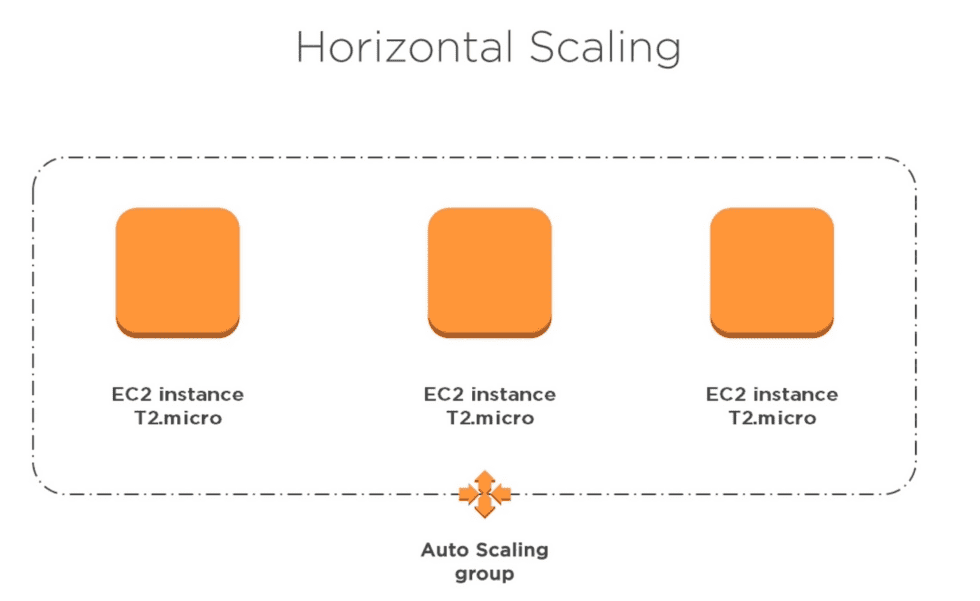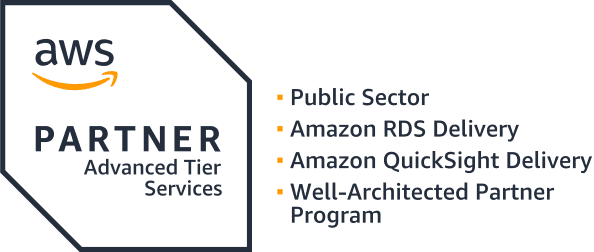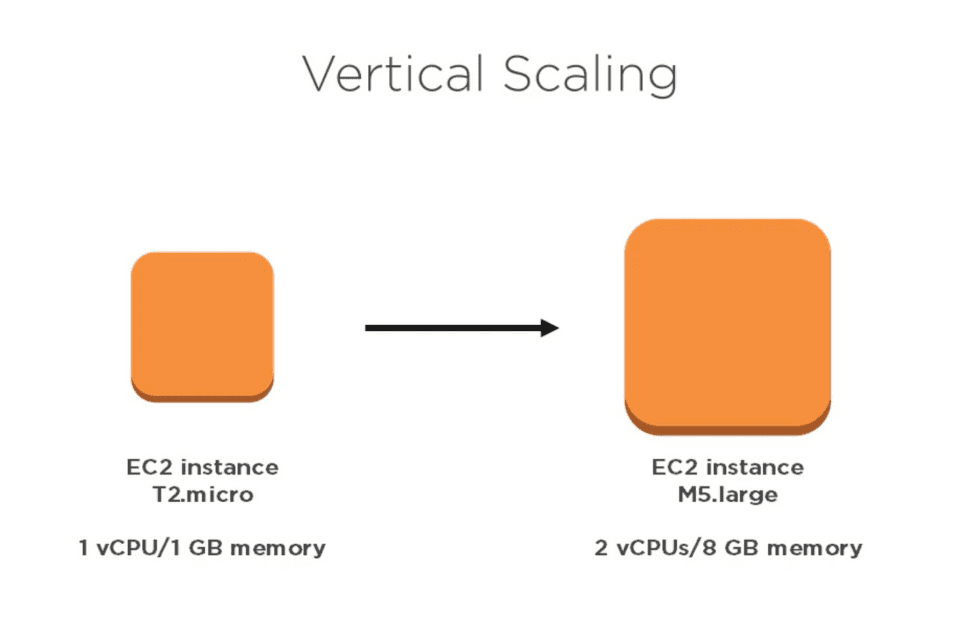Scalability and Increasing Demand
Scalability is defined as the flexibility of a system established in the cloud. Typically, this is applied when describing if an application can accept higher traffic or lower traffic without suffering too much strain. Scalability is the act of min-maxing costs, adjusting to surges in customer activity, and gaining access to additional resources as a service needs them.
This will severely impact how a website, web service, or application works, especially if it frequently sees fluctuating user traffic. The more flexible a service is, the less likely it is to crash or cause widespread issues in the user experience. The two main methods of scaling are horizontal scaling and vertical scaling.
Horizontal Scaling
Horizontal scaling provides additional nodes or computing assets to your system to better tolerate traffic. This approach is designed to add more units to process a workload and is limited by the physical capacity of servers hosted on the service. The purpose is to provide more nodes closer to some areas of the network or to offer more nodes in a particular region for users to access, or to have if any node experiences outages. In simpler terms, consider horizontal scaling as akin to increasing the number of call center employees to handle more calls simultaneously, rather than expecting a single employee to handle all the increased load.
Users wouldn’t have to pay much at the onset of the scaling process. You would be required to pay for additional devices when you opt for them. However, later on, your cost overheads would crop up in the form of cooling systems and space requirements. Upgrading a pre-existing server costs less than purchasing a new one and simplifies maintenance. You are less likely to require additional backup and virtualization software, potentially stabilizing maintenance costs.
Advantages
- Generally speaking, horizontal scaling is fundamentally straightforward when adding hardware. It simply involves integrating more machines into your existing system, sidestepping the need to analyze and upgrade system specifications. This makes scaling an easier and more flexible process.
- It usually results in fewer interruptions. By adding or removing machines, operations on existing machines remain unaffected, essential for maintaining continuous service availability and minimizing client impact.
- This approach also enhances fault tolerance significantly. With data and operations distributed across multiple nodes rather than concentrated in a single location, the risk of total system failure and data loss is substantially reduced. This distributed model protects your operations by preserving functionality even if one part of the system goes down.
- Having additional machines means improved handling of network traffic. This setup creates more endpoints, allowing for better distribution of load across the system, which can reduce bottlenecks and enhance overall efficiency.
Disadvantages
- Having more machines active means more instances to run and tend to. Using multiple servers also requires load balancing and virtualization software to help distribute the workload evenly across the board. Numerous instances can also run the risk of poor internal communication and desynchronization. The operational complexity increases as each new server must be integrated and adequately coordinated with the existing infrastructure.
- The financial aspect cannot be ignored. Expanding your hardware infrastructure by adding more machines generally incurs higher upfront costs than simply upgrading existing servers. This initial investment can be a significant consideration for any business.
Horizontal scaling allows you to circumvent latencies and outages. Unlike vertical scaling, you don’t have to shut down the servers to implement the scaling process. This operational benefit can result in cost savings by minimizing downtime and maintaining service continuity.
If your localized customer base demands higher processing power, vertical scaling might be a more appropriate choice. Although there may be latencies and outages involved, your clientele should be accepting of these aspects. Balancing these factors against the initial investment helps you make a more informed decision about whether horizontal or vertical scaling is more cost-effective for your specific needs.
As an advanced AWS partner, we bring unparalleled expertise to architect, deploy, and optimize cloud solutions tailored to your unique needs.
Use Cases
Whether it is once per year or a constant problem bombarding business operations, horizontal scaling should be considered. Despite its shortcomings, horizontal scaling is optimal for providing good performance for services that are dependent on a stable connection to the end user. Depending on how much traffic the service usually gets, this can result in very efficient price performance. Using proper microservices, performance can remain stable across all instances with careful planning.
More machines are also suitable for avoiding outages and how catastrophic they can be. If servers are more evenly distributed across global regions, end-users will receive both better performance and a reduced likelihood of one damaged node preventing access to the service entirely. With other instances capable of alleviating the burden of traffic, updates and upgrades can come more readily.
In scenarios where high performance is crucial to maintaining high-quality service, horizontal scaling is an invaluable strategy. It is particularly beneficial when running your application or services across different geographical locations to ensure low latency. The flexibility to configure machines in various ways also allows for optimal efficiency, specifically improving the price-performance ratio.
Horizontal scaling can be helpful when regular updates, upgrades, and optimizations are needed — all while aiming to minimize downtime. This approach is especially important for businesses experiencing consistently high usage, user growth, or traffic spikes expected to grow exponentially.
For those utilizing a micro-services architecture or containerized applications, horizontal scaling performs better on a distributed system. It also provides the necessary backup machines to reduce single points of failure, enhancing the overall resilience and reliability of the infrastructure.
Vertical Scaling
Vertical scaling refers to adding more power to your existing machines. This could involve upgrading the CPUs, expanding the memory, enhancing storage, or increasing network speeds. Essentially, vertical scaling is about enhancing the capabilities of your current infrastructure to meet demand, similar to giving that single call center employee a faster computer and better tools to manage more calls effectively.
Vertical scaling requires you to spend at the onset of the adoption itself. You will pay for the higher power, and effectively, it fares well in the initial stages. Upgrading a server involves enhancing the CPUs, memory, storage, or network speed, which can often be achieved at a lower financial and logistical cost compared to horizontal expansions. Maintenance will remain the same once the unit returns online with the replaced components.
Advantages
- Vertical scaling is reasonably cost-effective in the long term. The cost is comparatively low since the service providers merely upgrade existing nodes instead of buying new units. Upgrading a server involves enhancing the CPUs, memory, storage, or network speed, which can often be achieved at a lower financial and logistical cost compared to horizontal expansions. Maintenance will remain the same once the unit returns online with the replaced components.
- Upgrading a pre-existing server costs less than purchasing a new one and simplifies maintenance. You are less likely to require additional backup and virtualization software, potentially stabilizing maintenance costs. Furthermore, when a single node handles all the layers of your services, it eliminates the need for complex synchronization and communication with other machines, leading to faster response times and less complicated maintenance.
- Offers a simpler management scenario by upgrading existing hardware’s capabilities. While avoiding the complexities associated with networked instances, it is essential to consider the limitations inherent in this approach. Fewer nodes mean fewer instances requiring management and synchronization, simplifying the overall process. Similarly, software upgrades are less likely to happen, reducing the need for frequent software changes.
- Unless several nodes are being upgraded, there is typically less need to synchronize communication between nodes, and software upgrades are less likely to happen.
- Maintenance costs would be cheaper than horizontal scaling because there are fewer nodes to upkeep. This streamlined approach makes vertical scaling a cost-effective option and reduces the complexity of managing multiple machines and software environments.
Disadvantages
- The risks imposed by downtime are significantly higher. With fewer nodes at play, having one or two units down for maintenance could spell disaster since fewer nodes could work as backups.
- Similarly, having fewer nodes risks losing all your data. If all your important data is being kept on a single server, losing that server could cost all the information kept on it.
- You can only upgrade the hardware so much. There are physical limitations to what CPU is implemented or how much RAM, storage, and processing power is on a single node. Once these thresholds are reached, no further enhancements can be made without switching to new hardware, which can be costly and disruptive. If you focus exclusively on upgrading vertically, expanding horizontally will eventually become the only option to accommodate growth.
Use Cases
This topic must be discussed with the group’s engineers and stakeholders. All parties need to plan what CPUs and memory would be beneficial and how it would be possible to deliver on the price performance for such an upgrade. Regardless of the risks, vertical scaling tolerates much more sporadic traffic and is worth considering if the users are relatively new to the cloud. If redundancy is not a concern, additional upgrades are far and few between, and vertical scaling will be sufficient. Though it is recommended against legacy apps that don’t require distribution or scalability, they will benefit from vertical scaling.
Vertical scaling excels in managing sporadic traffic patterns and can be a valuable choice, especially for users who are new to cloud environments. It is particularly beneficial when redundancy is not a primary concern and upgrades are infrequent. However, it is essential to note that vertical scaling is not always the ideal solution for legacy applications that do not require distribution or scalability. These applications, which may not parallelize well or have architectural constraints limiting their efficiency across multiple machines, can significantly benefit from vertical scaling. By considering the computational power requirements and scalability limitations of the workload, organizations can make an informed decision on whether vertical scaling is the most suitable approach for their specific needs.
Determining the Best Path
Cost can often play a crucial role in deciding between different scaling options. While you may have specific goals or requirements for your organization, ultimately, the cost associated with each option may heavily influence your decision-making process.
For example, while horizontal scaling may seem like the ideal solution from a functional perspective, the financial resources required for implementation could be a determining factor. Your current budget may not allow such a scaling strategy, leading you to explore other alternatives. In such situations, it’s essential to consider all available options beyond just on-premise vertical and horizontal scaling. Migrating your infrastructure to a cloud service provider, for instance, could provide a cost-effective solution that also simplifies the scaling process.
To accurately assess the cost implications of different scaling options, you might consider utilizing a cloud cost management platform. This tool can help you evaluate and compare the expenses associated with on-premise scaling versus cloud solutions, allowing you to make an informed decision based on both current and future expenditure projections. By thoroughly analyzing the financial aspects of each option, you can determine which approach aligns best with your budget constraints and long-term financial objectives.
Using either method of scaling needs to be carefully evaluated before dedicating. Especially if the application is experiencing moments of high traffic and is subsequently suffering from it, either action should be considered for the health and wellbeing of the service. That is not to say either should be considered exclusively and that it isn’t possible to accomplish a mix of both.
Get Started Today!
At AllCode, our mission is to leverage our unique skillset and expertise to deliver innovative, top-tier software solutions that empower businesses to thrive in our world’s rapidly-evolving technological landscape.
Work with an expert. Work with AllCode




